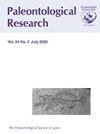美国内华达州埃尔科县Crittenden Springs含氨石灰岩块中的Smithian(Olenekian,三叠纪早期)牙形刺
IF 0.6
4区 地球科学
Q3 PALEONTOLOGY
引用次数: 8
摘要
摘要克里滕登斯普林斯(Crittenden Springs)菊石遗址的含菊石石灰岩块体属于下三叠统泰内斯群(Thaynes Group)的下部。这些0.5-1.2米厚的块体主要由生物碎屑浮石和乳石岩组成,包含丰富的宏观和微观化石,如菊石类、腹足类、双壳类和舟足类贝壳,以及牙形刺元素、鱼类和棘皮动物遗骸。利用从三个区块获得的菊石和牙形石组合进行生物地层学分析。根据年龄诊断分类群的范围,先前研究中的12个非正式史密斯安菊石生物地层学区间被浓缩为四个菊石层,按升序排列:Meekoceras millardense-M。aff。olivieri床、Owenites koeneni床、Anasibirites多形性床和Condenseceras youngi床。从三个区块中发现的牙形石由30种组成,分布在15个属中,其中包括一个新描述的分类单元,即Guangxidella minuta Maekawa和Jenks sp.nov。这些区块分为两个牙形石间隔带,即Novispathodus ex gr.waageni间隔带和Nv。平顶山间隔带,基于其同名分类群的首次出现。此外,根据这四个指数物种的范围,还识别出四个牙形刺山脉带,即Paullella meeki山脉带、Guangxidella bransoni山脉带、Scythogondolella milleri山脉带和Borinella buurensis山脉带。这些间隔带和范围带内的牙形石的年龄从史密阶中期到史密阶晚期不等。Smithian-Spathian边界(SSB)的主要菊石和牙形石分类群的存在,如AW(Anasibirites和Wasatchites)和GXP(Glyptofereras、Xenocerites和Pseudosageceras)菊石组合以及牙形石B.buurensis,Nv。平定山和米氏S.milleri表明,该研究区是Panthalassa东部地区SSB的重要参考点。本文章由计算机程序翻译,如有差异,请以英文原文为准。
Smithian (Olenekian, Early Triassic) Conodonts from Ammonoid-Bearing Limestone Blocks at Crittenden Springs, Elko County, Nevada, USA
Abstract. The ammonoid-bearing limestone blocks at the classic Crittenden Springs ammonoid site belong to the lower part of the Lower Triassic Thaynes Group. These 0.5–1.2 m thick blocks, consisting mainly of bioclastic floatstone and rudstone, contain abundant macro- and micro-fossils such as ammonoids, gastropods, bivalves and scaphopod shells, as well as conodont elements, fish and echinoid remains. Ammonoid and conodont assemblages obtained from three blocks are utilized for biostratigraphical analysis. Twelve informal Smithian ammonoid biostratigraphic intervals from a previous study are condensed into four ammonoid beds, based on the range of age-diagnostic taxa, in ascending order: Meekoceras millardense-M. aff. olivieri beds, Owenites koeneni beds, Anasibirites multiformis bed, and Condensoceras youngi bed. Conodonts recovered from the three blocks consist of 30 species distributed among 15 genera, including one newly described taxon, i.e., Guangxidella minuta Maekawa and Jenks sp. nov. The blocks are divided into two conodont interval zones, i.e., the Novispathodus ex gr. waageni Interval Zone and Nv. pingdingshanensis Interval Zone, based on the first occurrences of their eponymous taxa. Additionally, four conodont range zones, i.e., the Paullella meeki Range Zone, Guangxidella bransoni Range Zone, Scythogondolella milleri Range Zone, and Borinella buurensis Range Zone are recognized, based on the ranges of these four index species. Conodonts within these interval and range zones vary in age from middle Smithian to latest Smithian. The presence of key ammonoid and conodont taxa regarding the Smithian-Spathian boundary (SSB) such as the AW (Anasibirites and Wasatchites) and GXP (Glyptophiceras, Xenoceltites and Pseudosageceras) ammonoid assemblages and the conodonts B. buurensis, Nv. pingdingshanensis and S. milleri demonstrate that the study area is an important reference site for the SSB in the eastern Panthalassa area.
求助全文
通过发布文献求助,成功后即可免费获取论文全文。
去求助
来源期刊

Paleontological Research
PALEONTOLOGY-
CiteScore
1.60
自引率
0.00%
发文量
47
审稿时长
>12 weeks
期刊介绍:
Paleonotological Research (PR) is a quarterly, peer-reviewed international journal, which focuses on original contributions primarily in the area of paleontology but also covering a wide range of allied sciences. It has been published since 1997 as a successor to the former journal Transactions and Proceedings of the Palaeontological Society of Japan. The emphasis of contributions will include global and local perspectives, and contents can cover all ages (Precambrian to the Quaternary, including the present time).
 求助内容:
求助内容: 应助结果提醒方式:
应助结果提醒方式:


